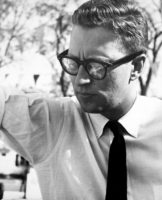The art and architecture worlds have come together of late for several exhibitions at some of the most prominent art galleries in New York. The Marlborough Gallery announced this spring that it was adding Spanish architect and engineer Santiago Calatrava to its roster of artists, just in time to feature his work during the all-important Armory Show. Often the subject of solo exhibitions at museums worldwide, Maya Lin’s Here and There at Pace Gallery just closed.
The latest convergence of these sometimes disparate worlds takes place at Gagosian’s 21st Street location, where an exhibition of work by the Renzo Piano Building Workshop drew throngs of architects, designers, students, curious onlookers, high-profile clients, and A-list celebrities, including Meryl Streep, to its opening last Thursday.
But unlike the Calatrava and Lin shows, which featured smaller-scale sculptural works unrelated to specific architectural projects, the Gagosian exhibition features sketches, hand drawings, models, full scale mock-ups, photographs, and videos of more than 30 years of Piano’s architecture, spanning 24 projects—none of which is for sale. The purpose of the exhibition, according to the gallery, is to educate and expand the knowledge of architecture, something Gagosian seems equipped to do since attendance at some of its recent shows, including one of paintings by Jean-Michel Basquiat, has surpassed average attendance rates at many museums. “It’s impossible to show architecture,” Renzo Piano said during the opening. “You have to experience it. What we’ve done is try to put pieces together.”
Entitled Fragments, the architect’s work is spread out over 24 large tables, around which chairs are set up to encourage dialogue, as if in a classroom. Each table spotlights a specific, well-known building including the Centre Georges Pompidou in Paris, the Menil Collection in Houston, the New York Times Building, and Kansai International Airport. A private residence in Colorado belonging to the Pritzker family is also included—the only one Piano designed—as well as Piano’s project for the Stavros Niarchos Foundation Cultural Center in Athens, which supported the exhibition.
In addition to the items on display on the tables, including building materials like the colorful terracotta tiles used in London’s Central St. Giles complex, large photographs and scale models of building components hang from the ceiling. Piano likes the simple, industrial quality of Gagosian’s gallery, as well as its proximity to his New York office. His current building project for the Whitney Museum of Art in Manhattan’s nearby Meatpacking District is also on display.
Having become the go-to architect for many prestigious museum projects across the globe, Piano has skillfully navigated the worlds of art and architecture for decades. “I am a builder,” he says. “But I also know that architecture is much more than building—it’s history, art, community, anthropology. That is the reason I love to make public buildings, and buildings that are homes for the arts.”









Post a comment to this article
Report Abusive Comment